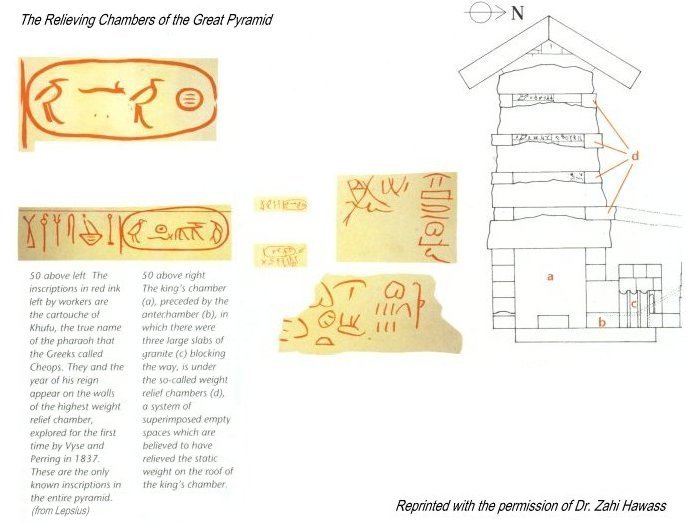

The Great Pyramid of Khufu has always stirred the imagination and wonder
of people. Some people have written non-scientific books about the Pyramid of
Khufu, claiming that the pyramid was built by a lost civilization, known as
Atlantis. In their public lectures they have even claimed that the only
evidence that Khufu built the pyramid is the graffiti found in the five chambers
that are located above the king’s chamber. They claimed that this
graffiti was not written by the workmen who built the pyramid but written by
scholars and adventurers who entered the pyramid in the 19th century. The
‘Pyramidiots,’ as I like to call these people, claim that the five chambers
are unique and that we have never seen them in any other pyramids, and they take
that as proof that the Great Pyramid was not built by the ancient Egyptians.
It is easy for the public to believe the Pyramidiots because their false stories
are interesting, exciting and romantic; some people would rather believe a fairy
tale than our scientific explanations.
A few years ago we closed the Great Pyramid to do conservation work and
improve the ventilation system. During this time we started to clean the five
chambers and took away the stone rubble to clean them. It was very
interesting to read on the internet and to hear from everyone that the
Pyramidiots were saying that we were secretly digging inside the pyramid and
that one of the inspectors had found a papyri that explained that the Great
Pyramid was built by people who came from Atlantis. They claimed that I took the
papyri, hid it, and then fired the inspector. The Pyramidiots have incredible
imaginations.
I told my student Leslie Warden at the American University in Cairo to
inform the rest of the students in my class that we were going on an adventure
inside the Great Pyramid of Khufu and that we would enter the five relieving
chambers. Leslie smiled and enthusiastically told me that they would love to
join me on this adventure. I told Marli Pope to be ready with her digital
camera to record everything we would see inside the chambers. The next
day, Leslie called me and confirmed that all my students would meet me at my
office to begin the adventure. I asked Abdou El-Hamied Kotb, the architect at
Giza, to prepare a ladder that we could use to climb up to the five chambers.
The chambers are about four meters above the entrance of the third burial
chamber. The third burial chamber in Khufu’s pyramid has no parallel.
It consists of nine big granite slabs, each weighing about 40 tons, and above
the flat ceiling are five separate rooms. We call these rooms the five relieving
chambers.
On the day we were to go, Leslie, smiling and
jumping with enthusiasm said, “Dr. Hawass, we are ready for the adventure!”
My assistant, Brook, asked if she could join us. She was thrilled to
be included on this exciting trip. We entered the Great Pyramid, passing
through the grand gallery until we reached the entrance of the King’s chamber.
You could feel the excitement in the air. Leslie said that I should lead
the way. We started to climb the ladder until we reached the first room. The
ceilings of the first four rooms are flat, while the fifth has a pointed
ceiling. I believe that the purpose of building the five chambers was to
eliminate any risk of the ceiling of the king’s chamber collapsing under the
weight of the superincumbent masonry. I took Will, Leslie and Christine to
see some of the ancient graffiti that read, “friends of Khufu.” This
is one of the names of the crew who built Khufu’s pyramid. I also showed
them the sign of life, the sign of a pyramid, and an inscription that says,
“year 17 of Khufu’s reign.” The most interesting discovery
here that I found was graffiti written behind one of the blocks that no one else
could have written except the workmen who moved this stone. The students were in
awe and wonder. They felt like they were a part of the Great Pyramid as
they stood in its heart and saw the evidence of the ancient Egyptians who built
this incredible monument.
It was an amazing adventure. We came back climbing, our hearts were
pounding with our excitement; we were sweating and dirty as we moved above the
rocks. My students leaped around like gazelles. Leslie said, “You are
getting old, Dr. Hawass.” I told my students that I had some good news
for them. All of them said in one voice, “What?” Today, I informed
them, the French team had found three relieving chambers above the main corridor
inside the Pyramid at Meidum. This shows that the relieving chambers inside the Great
Pyramid of Khufu are not connected only with Khufu but are found in other
pyramids and this can answer the question of the Pyramidiots…. My students
started to laugh, the sound of their delight thundered and grew louder and
louder echoing through the Grand Gallery of Khufu’s Pyramid. It seemed
to take on a life of its own, leaving the pyramid and dancing over the plateau.